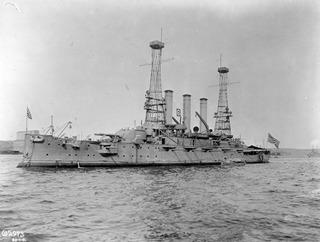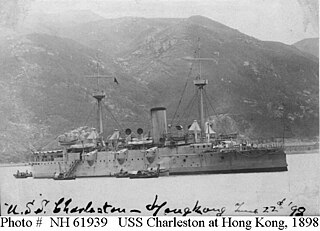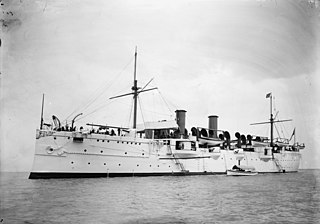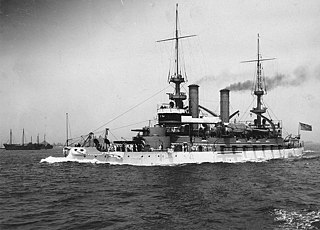
USS Massachusetts was an Indiana-class, pre-dreadnought battleship and the second United States Navy ship comparable to foreign battleships of its time. Authorized in 1890, and commissioned six years later, she was a small battleship, though with heavy armor and ordnance. The ship class also pioneered the use of an intermediate battery. She was designed for coastal defense and as a result, her decks were not safe from high waves on the open ocean.

USS Alabama (BB-8) was an Illinois-class pre-dreadnought battleship built for the United States Navy. She was the second ship of her class, and the second to carry her name. Her keel was laid down in December 1896 at the William Cramp & Sons shipyard, and she was launched in May 1898. She was commissioned into the fleet in October 1900. The ship was armed with a main battery of four 13-inch (330 mm) guns and she had a top speed of 16 knots.

USS Nebraska (BB-14) was a Virginia-class pre-dreadnought battleship of the United States Navy, the second of five members of the class, and the first ship to carry her name. She was built by the Moran Brothers shipyard in Seattle, Washington, with her keel-laying in July 1902 and her launching in October 1904. The completed ship was commissioned into the US Navy in July 1907. The ship was armed with an offensive battery of four 12-inch (305 mm) guns and eight 8-inch (203 mm) guns, and she was capable of a top speed of 19 knots.

USS Maine (BB-10), the lead ship of her class of pre-dreadnought battleships, was the second ship of the United States Navy to be named in honor of the 23rd state. Maine was laid down in February 1899 at the William Cramp & Sons shipyard in Philadelphia. She was launched in July 1901 and commissioned into the fleet in December 1902. She was armed with a main battery of four 12-inch (305 mm) guns and could steam at a top speed of 18 knots.

USS Brooklyn (ACR-3/CA-3) was the third United States Navy armored cruiser, the only one to be named at commissioning for a city rather than a state.

USS Missouri (BB-11), a Maine-class battleship, was the second ship of her class and of the United States Navy to be named in honor of the 24th state. Missouri was laid down in February 1900 at the Newport News Shipbuilding & Drydock Company, was launched in December 1901, and was commissioned into the fleet in December 1903. She was armed with a main battery of four 12-inch (305 mm) guns and could steam at a top speed of 18 knots.

USS Georgia (BB-15) was a United States Navy Virginia-class battleship, the third of five ships of the class. She was built by the Bath Iron Works in Maine, with her keel laid in August 1901 and her launching in October 1904. The completed battleship was commissioned into the fleet in September 1906. The ship was armed with an offensive battery of four 12-inch (305 mm) guns and eight 8-inch (203 mm) guns, and she was capable of a top speed of 19 knots.

USS Wyoming (BB-32) was the lead ship of her class of dreadnought battleships and was the third ship of the United States Navy named Wyoming, although she was only the second named in honor of the 44th state. Wyoming was laid down at the William Cramp & Sons in Philadelphia in February 1910, was launched in May 1911, and was completed in September 1912. She was armed with a main battery of twelve 12-inch (305 mm) guns and capable of a top speed of 20.5 kn.

USS Amsterdam was a Cleveland-class light cruiser of the United States Navy, which were built during World War II. The class was designed as a development of the earlier Brooklyn-class cruisers, the size of which had been limited by the First London Naval Treaty. The start of the war led to the dissolution of the treaty system, but the dramatic need for new vessels precluded a new design, so the Clevelands used the same hull as their predecessors, but were significantly heavier. The Clevelands carried a main battery of twelve 6-inch (152 mm) guns in four three-gun turrets, along with a secondary armament of twelve 5 in (127 mm) dual-purpose guns. They had a top speed of 32.5 knots.

The second USS Charleston (C-2) was a United States Navy protected cruiser — the fourth US protected cruiser to be built. Lacking experience in building steel cruisers, the design was purchased from the British company Armstrong, Mitchell and Co. of Newcastle, the construction to be by an American shipyard. In design, she succeeded the "ABC" cruisers Atlanta, Boston, and Chicago with better protection, higher speed, and similar armament.

The Indiana class was a class of three pre-dreadnought battleships launched in 1893. These were the first battleships built by the United States Navy comparable to contemporary European ships, such as the British HMS Hood. Authorized in 1890 and commissioned between November 1895 and April 1896, these were relatively small battleships with heavy armor and ordnance that pioneered the use of an intermediate battery. Specifically intended for coastal defense, their freeboard was insufficient to deal well with the waves of the open ocean. The turrets lacked counterweights, and the main belt armor was placed too low to be effective under most conditions.

USS North Carolina (ACR-12/CA-12) was a Tennessee-class armored cruiser of the United States Navy. The ship was built by Newport News Shipbuilding; she was laid down in March 1905, launched in October 1906, and was commissioned in May 1908. The final class of armored cruisers to be built for the US Navy, North Carolina and her sisters were armed with a main battery of four 10-inch (254 mm) guns, and were capable of a top speed of 22 knots.

The fourth USS Philadelphia (C-4) was the sixth protected cruiser of the United States Navy. Although designed by the Navy Department, her hull was similar to the preceding British-designed Baltimore, but Philadelphia had a uniform main armament of twelve 6-inch guns.

The Kearsarge-class was a group of two pre-dreadnought battleships built for the United States Navy in the 1890s. The two ships—USS Kearsarge and USS Kentucky—represented a compromise between two preceding battleship designs, the low-freeboard Indiana class and the high-freeboard USS Iowa, though their design also incorporated several improvements. Their primary advances over earlier designs consisted of new quick-firing guns and improved armor protection, but their most novel feature was their two-story gun turrets that consisted of a secondary 8-inch (203 mm) gun turret fixed to the top of their primary 13-inch (330 mm) turrets. The ships suffered from a number of problems, however, including a tertiary battery mounted too low in the hull and poorly-designed turrets, though the latter were attempted again with the Virginia class in the early 1900s, also with negative results.

The Illinois class was a group of three pre-dreadnought battleships of the United States Navy commissioned at the beginning of the 20th century. The three ships, Illinois, Alabama, and Wisconsin, were built between 1896 and 1901. They were transitional ships; they incorporated advances over preceding designs, including the first modern gun turrets for the main battery, and new rapid-firing secondary guns, but they were also the last American battleships to feature dated technologies like fire-tube boilers and Harvey armor. They were armed with a main battery of four 13-inch (330 mm) guns in two twin turrets, supported by a secondary battery of fourteen 6 in (150 mm) guns. The ships had a designed speed of 16 knots, though they exceeded that speed by a significant margin.

The Florida-class battleships of the United States Navy comprised two ships: Florida and Utah. Launched in 1910 and 1909 respectively and commissioned in 1911, they were slightly larger than the preceding Delaware class design but were otherwise very similar. This was the first US battleship class in which all ships received steam turbine engines. In the previous Delaware-class, North Dakota received steam turbine propulsion as an experiment while Delaware retained triple-expansion engines.

USS Portsmouth was a Cleveland-class light cruiser of the United States Navy, which were built during World War II. The class was designed as a development of the earlier Brooklyn-class cruisers, the size of which had been limited by the First London Naval Treaty. The start of the war led to the dissolution of the treaty system, but the dramatic need for new vessels precluded a new design, so the Clevelands used the same hull as their predecessors, but were significantly heavier. The Clevelands carried a main battery of twelve 6-inch (152 mm) guns in four three-gun turrets, along with a secondary armament of twelve 5 in (127 mm) dual-purpose guns. They had a top speed of 32.5 knots. Portsmouth was laid down in 1943, launched in September 1944, and commissioned in June 1945. By the time she completed her initial sea trials, the war had ended, so her career was short and uneventful. She made three overseas cruises to visit ports in Africa and the Mediterranean Sea between 1946 and 1948 before conducting training cruises later in 1948. The following year, she was decommissioned and assigned to the Atlantic Reserve Fleet, where she remained until 1970, when she was broken up.

The Pennsylvania class of six armored cruisers served in the United States Navy from 1905 to 1927. All six were renamed for cities 1912–1920, to make the state names available for the new battleships beginning with the Pennsylvania-class battleships. All of these served during World War I, with California being the only ship of the class to be lost. The remaining five armored cruisers were scrapped between 1930 and 1931 in accordance with the London Naval Treaty.

USS Atlanta was a protected cruiser and one of the first steel warships of the "New Navy" of the 1880s. In some references she is combined with Boston as the Atlanta class, in others as the Boston class.

The Tennessee-class cruisers were four armored cruisers built for the United States Navy between 1903 and 1906. Their main armament of four 10-inch (254 mm) guns in twin turrets was the heaviest carried by any American armored cruiser. Their armor was thinner than that of the six Pennsylvanias which immediately preceded them, a controversial but inevitable decision due to newly imposed congressional restraints on tonnage for armored cruisers and the need for them to be able to steam at 22 knots. However, the fact their armor covered a wider area of the ship than in the Pennsylvanias and their increased firepower caused them to be seen by the Navy as an improvement.
























